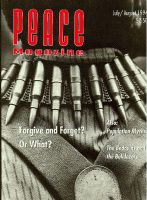
Peace Magazine Jul-Aug 1994, page 23. Some rights reserved.
Search for other articles by Maxine Kaufman Nunn here
Jerusalem suburban expansion threatens Bedouin community
The tent shared by Sarah and Muhammad Abu Ghalia and their five children stands in a cluster of wood and tin shacks in a hollow close to the old Jericho road. Their goats are penned nearby and hens and roosters wander about freely, sometimes venturing into the tent in search of dropped crumbs. When the tent-flaps are lifted, the family can look out on the high-rise apartments and water tower of the "new section" of Ma'ale Adumim a few metres to their left. The rolling hills to the right are slashed by denuded swaths slated to be access roads for an even newer section of this sprawling suburb of "Greater Jerusalem." And straight ahead is the hill where, on February 6, Muhammad and 15 other people sat in the path of a bulldozer rather than allowing it to proceed with the work which is increasingly encroaching on their community.
Part of the price of this expansion is the uprooting of Sarah and Muhammad's young family and another 150 members of the Jahalin Bedouin tribe, which has already been forced to move twice in the last 44 years.
The Jahalin first had to pull up stakes in 1950. Ousted from their home on the site of the present Israeli city of Arad, they made their way to the Jordanian border south of Hebron. A few years later they were among the approximately 20,000 Bedouins "encouraged" by the military to leave Israeli territory for the West Bank, then under Jordanian administration. They subsequently settled in their present location, on the edge of the Judaean Desert between Jerusalem and Jericho. Some 25 years later, their solitude was broken by the founding of the settlement city of Ma'ale Adumim, whose modern high-rise apartments have gradually come to dominate much of the skyline. And now Ma'ale Adumim is expanding to accommodate more Israeli Jewish residents, and the Jahalin have again been ordered to move.
Israel is working feverishly to create continuity of Jewish habitation between "metropolitan Jerusalem" and Ma'ale Adumim, cutting off the Jericho enclave from the rest of the West Bank. "Then," Mayor Benny Kashriel points out, "in three years -when they start to negotiate all of Judea and Samaria-Ma'ale Adumim will be a part of Israel or of Greater Jerusalem." The Jahalin, living literally on Ma'ale Adumim's doorstep, are the first in line for displacement.
By last October the bulldozers of progress had reached the periphery of the encampment, gradually biting off more and more of the tribe's grazing land. Road-blasting sent rocks flying onto tents and through the flimsy roofs of shacks, inducing some 20 families to "voluntarily" move to a rocky site about a mile away.
The Jahalin turned for help to a human rights resource and legal aid centre, the society of St. Yves, which filed a petition on December 6 for an urgent hearing. The following week the government proposed an alternative site. However, a number of points, notably the fact that the area is a rocky hillside close to the Jerusalem garbage dump, prompted their St. Yves lawyer to reject the offer on behalf of the tribe. The Jahalin have additional reservations about the proposed site which, although purportedly "state land," was in fact expropriated from people in the village of Abu Dis who still claim ownership. A proposal made by the Jahalin themselves for a parcel of government land at Ras al Azariyah, which they are sure was not expropriated from other Palestinians, was rejected out of hand by the authorities.
A hearing was ultimately scheduled but no temporary injunction was granted stopping work during that period. The bulldozers moved closer. Twenty-one of the 40 remaining families declared their intention not to move voluntarily. An Action Committee for the Jahalin Tribe (ACJT), a grassroots group of Israelis, Palestinians, and internationals, is therefore conducting a public campaign on their behalf. Since mid January ACJT members have taken turns spending the night at the encampment, sleeping in the Abu Ghalia's tent, providing moral support and a visible "outside" presence as well as assurance that, should the authorities attempt to forcibly remove the Jahalin, there would be someone there to phone the media and supporters.
Moreover, delegations of internationals and of Israelis with dual citizenship have presented the issue to their respective consulates, and the ACJT maintains ongoing contact with sympathetic officials such as Israeli Environment Minister Yossi Sarid and Palestinian leader Faisal Husseini. The issue is receiving attention from the international press.
On May 31 the Israeli High Court of Justice (the state's highest court of appeal) upheld a new petition on behalf of the Jahalin brought by St. Yves arguing that the eviction of the Jahalin to make way for housing for Jewish settlers constitutes religious and ethnic discrimination. There were 26 Israeli copetitioners including such well-known figures as Nuri al-Ugbi of the Association for Support and Defense of Bedouin Rights in Israel, Shlomo Elbaz of the oriental Jewish peace group East for Peace, and Tovia Ben Horin, rabbi of Israel's oldest reform synagogue.
The fact that the petition was heard before a full complement of five justices (rather than the more usual panel of three), with the Attorney General in attendance, was an indication that the Jahalin issue has come to be taken seriously.
Letters and faxes in support of the Jahalin should be addressed to Israeli Prime Minister Yitzhak Rabin, Kiryat Hamemshalah, Jerusalem, Israel; Fax 972-2-664838, and to your local Israeli consulate or embassy. The ACJT requests copies, c/o Box 32213, Jerusalem.
Maxine Nunn, who used to live in Toronto, now lives in Israel.

Peace Magazine Jul-Aug 1994, page 23. Some rights reserved.
Search for other articles by Maxine Kaufman Nunn here